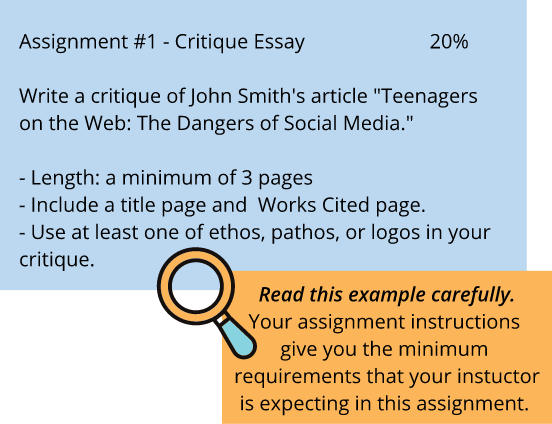36
You need a clear understanding of what the instructor wants before starting on any assignment of project. Then you will want to translate assignment terms and requirements into useful clues as to what your instructor expects. When you are not sure, remember to ask the instructor.
The first step is to read the assignment carefully as soon as you receive it.

Interpreting the Assignment
Ask yourself a few basic questions as you read and jot down the answers on the assignment sheet:
- Why did your instructor ask you to do this particular task?
- Who is your audience?
- What kind of evidence do you need to support your ideas?
- What kind of writing style is acceptable?
- What guidelines must you follow?
Terms that might be used
- Identification Terms: cite, define, enumerate, give, identify, indicate, list, mention, name, state.
- Description Terms: describe, discuss, review, summarize, diagram, illustrate, sketch, develop, outline, trace.
- Relation Terms: analyze, compare, contrast, differentiate, distinguish, relate.
- Demonstration Terms: demonstrate, explain why, justify, prove, show, support.
- Evaluation Terms: assess, comment, criticize, evaluate, interpret, propose.
Begin with Background Content
Most assignment will be related to the materials you have studied in the course up to the point of the assignment. As you read the assignment or project requirements, start by identifying which theories, formulas, and graphics relate. Consider what research you will need to do to complete the project.
Use the Rubric!
Your assignment instructions and rubric are two of your key tools throughout the process of completing the assignment. These provide an outline of the criteria that the instructor has set out for a successful assignment. There are two key times to use the rubric and assignment instructions:
- Before you start writing: Unfortunately, time may be lost writing something that does not meet the key guidelines you must follow. To avoid this problem, take time to read both the assignment instructions and rubric carefully before beginning. Clarify any areas of confusion with your instructor.
- After you have written a draft, but before you submit the assignment: At this point, grade your work according to the rubric. Think carefully and critically. Are there areas where you may not have met the criteria well? If so, edit your work accordingly, making the needed revisions before submitting the assignment.
Try it!
Take out your assignment instructions and rubric. Use them to answer the following questions:
- Describe in one sentence your task on this assignment: What do you need to do?
- What resources will you use to complete this assignment? Review any textbook materials, handouts, or class notes that relate to this assignment. How many additional resources do you need to find to complete the assignment task? (consider books, peer reviewed articles, websites, or other resources).
- What content do you need to create for this assignment?
- What guidelines do you need to follow related to the format of the assignment? What format do you need to use for citations and references (APA, MLA, and Chicago are the most commonly used).
